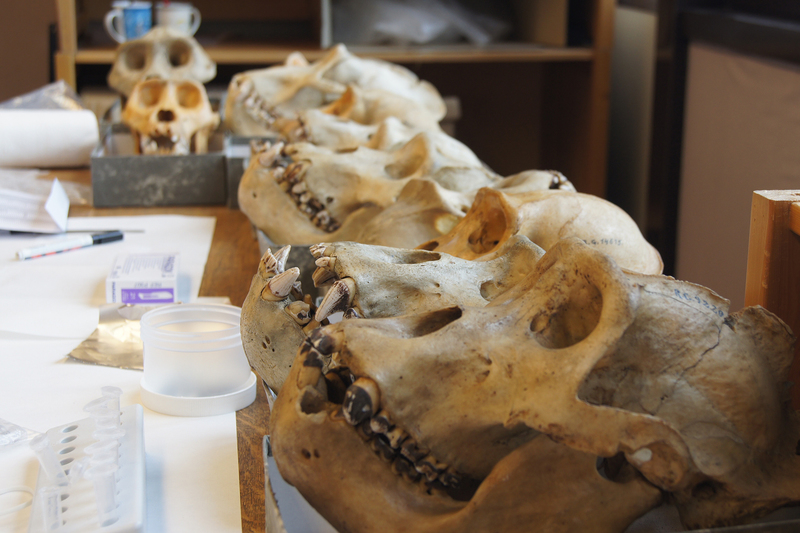Oral microbiome study unearths surprising clues about human evolution
12 May 2021 | Story Staff writer. Photo Felix Wey, Werner Siemens Foundation. Read time 7 min.
Global collaboration reveals unexpected findings about early human behaviour and novel insights into the evolution of the hominid microbiome.
A new study by a multidisciplinary international research team, including University of Cape Town (UCT) biological anthropologist, Associate Professor Victoria Gibbon, has discovered unexpected clues about human evolution and health after reconstructing the oral microbiomes of Neanderthals, primates and humans, including the oldest oral microbiome ever sequenced from a 100 000-year-old Neanderthal.
The study, “The evolution and changing ecology of the African hominid oral microbiome”, has been published in the Proceedings of the National Academy of Sciences. The team, a global collaboration led by scientists from the Max Planck Institute for the Science of Human History (MPI-SHH), investigates the evolutionary history of the hominid oral microbiome by analysing the fossilised dental plaque of humans and Neanderthals and comparing it to those of wild chimpanzees, gorillas, and howler monkeys.
Says Gibbon, “In recent years, the human microbiome has become a popular topic, using bacterial DNA obtained from tooth plaque from South African people who lived thousands of years ago, contributing to the better understanding of human history, human evolution and our early diets.”
Surprising findings about early human behaviour
Researchers from 41 institutions in 13 countries contributed to the study, making this the largest and most ambitious study of the ancient oral microbiome to date.
“In recent years, the human microbiome has become a popular topic, using bacterial DNA obtained from tooth plaque from South African people who lived thousands of years ago, contributing to the better understanding of human history, human evolution and our early diets.”
Their analysis of dental calculus from more than 120 individuals representing key points in primate and human evolution has revealed surprising findings about early human behavior and novel insights into the evolution of the hominid microbiome, including that the shift to diets based predominately on starch occurred much earlier than previously thought and long before the advent of agriculture.
Starchy foods, such as roots, tubers and seeds are rich sources of energy, and previous studies have argued that a transition to eating starchy foods may have helped our ancestors to grow the large brains that characterise our species.
The most challenging jigsaw puzzle in the world
Working with DNA tens or hundreds of thousands of years old is highly challenging, and like archaeologists reconstructing broken pots, archaeogeneticists must painstakingly piece together the broken fragments of ancient genomes in order to reconstruct a complete picture of the past.
For this study, researchers had to develop new tools and computational approaches to genetically analyse billions of DNA fragments and identify the long-dead bacterial communities preserved in archaeological dental calculus. Using these new tools, researchers reconstructed the 100 000-year-old oral microbiome of a Neanderthal from Pešturina Cave in Serbia, the oldest oral microbiome successfully reconstructed to date by more than 50 000 years.
“We were able to show that bacterial DNA from the oral microbiome preserves at least twice as long as previously thought,” says James Fellows Yates, lead author and doctoral candidate at the Max Planck Institute for the Science of Human History. “The tools and techniques developed in this study open up new opportunities for answering fundamental questions in microbial archaeology and will allow the broader exploration of the intimate relationship between humans and their microbiome.”
Paleolithic connections
Although humans share many oral bacteria with other primates, the oral microbiomes of humans and Neanderthals are particularly similar. Nevertheless, there are a few small differences, mostly at the level of bacterial strains. When the researchers took a closer look at these differences, they found that ancient humans living in Ice Age Europe shared some bacterial strains with Neanderthals.
Because the oral microbiome is typically acquired in early childhood from caregivers, this sharing may reflect earlier human-Neanderthal pairings and child rearing, as has also been already indicated by the discovery of Neanderthal DNA in ancient and modern human genomes. Researchers found that Neanderthal-like bacterial strains were no longer found in humans after ca. 14 000 years ago, a period during which there was substantial population turnover in Europe at the end of the last Ice Age.
An enduring microbial community
Despite oral microbiome differences, researchers identified ten core bacterial types maintained within the human lineage for over 40 million years and that are still shared between humans and their closest primate relatives.
“We were able to show that bacterial DNA from the oral microbiome preserves at least twice as long as previously thought.”
Many of these bacteria are known to have important beneficial functions in the mouth and may help promote healthy gums and teeth. A surprising number of these bacteria, however, are so understudied that they even lack species names.
“That many of the most important taxa are poorly characterised is a surprise to oral microbiologists who have been working on these bugs for years,” said Floyd Dewhirst, senior member of staff at the Forsyth Institute and a co-author on the study. “We’re still learning about new members of this community, and these results give us new species to target for full characterisation.”
Indeed, as Gibbon concludes, “This study is the first of many of its kind to follow. The ability to analyse the diets of ancient peoples at this level has the potential to answer many questions around past peoples and their lifeways across Africa and within South Africa. The research outcomes from the study are exciting but they are just the beginning.”
 This work is licensed under a Creative Commons Attribution-NoDerivatives 4.0 International License.
This work is licensed under a Creative Commons Attribution-NoDerivatives 4.0 International License.
Please view the republishing articles page for more information.










